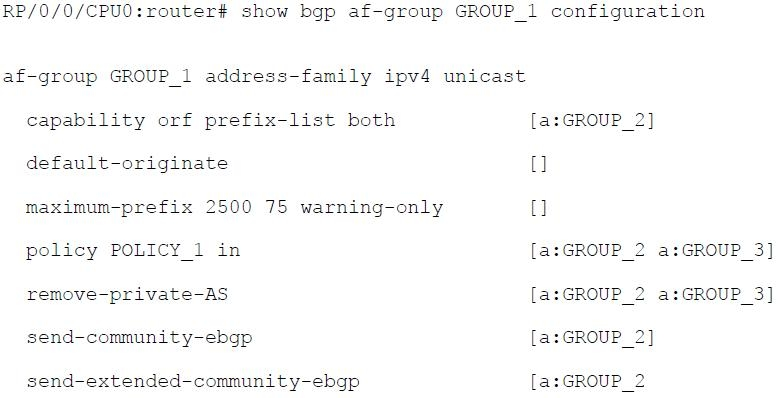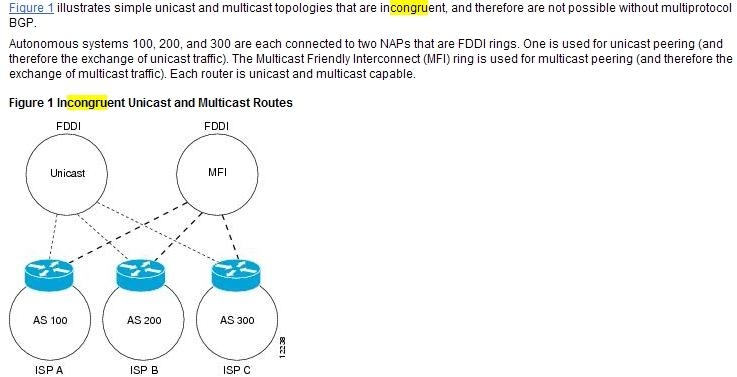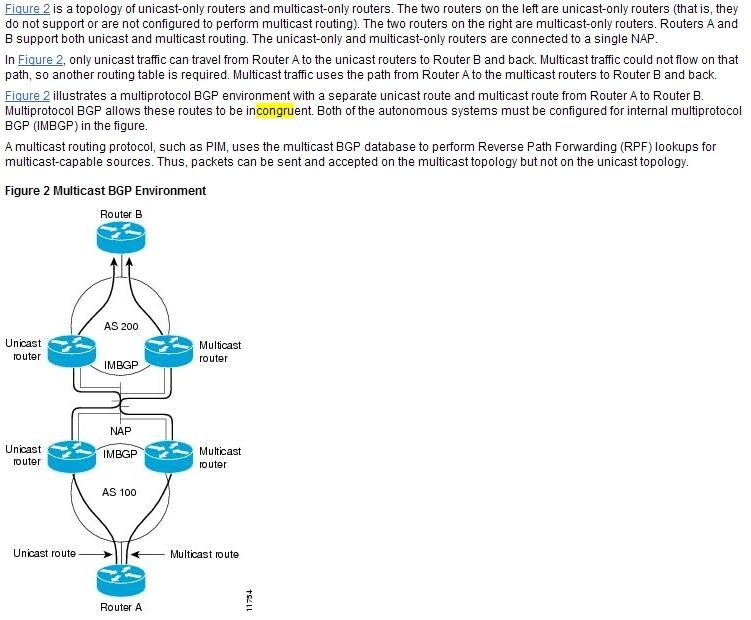Cisco® 642-885 Exam Practice Questions (P. 4)
- Full Access (131 questions)
- Six months of Premium Access
- Access to one million comments
- Seamless ChatGPT Integration
- Ability to download PDF files
- Anki Flashcard files for revision
- No Captcha & No AdSense
- Advanced Exam Configuration
Question #16
Refer to the Cisco IOS-XR show output exhibit.

Which statement is correct?

Which statement is correct?
- AThe [ ] indicates the configuration has a problem
- BThe [ ] indicates the 10.1.1.1 neighbor peering session has not been established
- CThe [ ] indicates the configuration was not inherited from a group
- DThe [ ] indicates the configuration has not been committed
- EThe [ ] indicates the corresponding BGP peer configuration has a mismatch configuration
Correct Answer:
C
show bgp neighbors
Use the show bgp neighbors command to display information about the BGP configuration for neighbors.
Use the configuration option to display the effective configuration for the neighbor, including any settings that have been inherited from session groups, neighbor groups, or af-groups used by this neighbor.
Use the inheritance option to display the session groups, neighbor groups, and af-groups from which this neighbor inherits configuration settings.
The following example displays sample output from the show bgp af-group command using the configuration keyword. This example shows where each configuration item was inherited from. The default-originate command was configured directly on this address family group (indicated by [ ]). The remove-private- as command was inherited from address family group GROUP_2, which in turn inherited from address family group GROUP_3:

C
show bgp neighbors
Use the show bgp neighbors command to display information about the BGP configuration for neighbors.
Use the configuration option to display the effective configuration for the neighbor, including any settings that have been inherited from session groups, neighbor groups, or af-groups used by this neighbor.
Use the inheritance option to display the session groups, neighbor groups, and af-groups from which this neighbor inherits configuration settings.
The following example displays sample output from the show bgp af-group command using the configuration keyword. This example shows where each configuration item was inherited from. The default-originate command was configured directly on this address family group (indicated by [ ]). The remove-private- as command was inherited from address family group GROUP_2, which in turn inherited from address family group GROUP_3:

send
light_mode
delete
Question #17
Which two statements correctly describe the RPF check when a multicast packet arrives at a router? (Choose two.)
- AThe router looks up the source address in the unicast routing table to determine if the packet has arrived on the interface that is on the reverse path back to the source
- BThe router looks up the destination address in the unicast routing table to determine if the packet has arrived on the interface that is on the reverse path back to the destination
- CIf the packet has arrived on the interface leading back to the destination, the RPF check passes and the packet is forwarded. If the RPF check fails, the packet is dropped
- DIf the packet has arrived on the interface leading back to the source, the RPF check passes and the packet is forwarded. If the RPF check fails, the packet is
Correct Answer:
AD
Reverse Path Forwarding (RPF)
RPF is a fundamental concept in multicast routing that enables routers to correctly forward multicast traffic down the distribution tree. RPF makes use of the existing unicast routing table to determine the upstream and downstream neighbors. A router will only forward a multicast packet if it is received on the upstream interface.
This RPF check helps to guarantee that the distribution tree will be loop free.
RPF Check -
When a multicast packet arrives at a router, the router will perform an RPF check on the packet. If the RPF check is successful, the packet will be forwarded.
Otherwise it will be dropped.
For traffic flowing down a source tree, the RPF check procedure works as follows:
Step 1. Router looks up the source address in the unicast routing table to determine if it has arrived on the interface that is on the reverse path back to the source.
Step 2. If packet has arrived on the interface leading back to the source, the RPF check is successful and the packet will be forwarded.
Step 3. If the RPF check in 2 fails, the packet is dropped.
AD
Reverse Path Forwarding (RPF)
RPF is a fundamental concept in multicast routing that enables routers to correctly forward multicast traffic down the distribution tree. RPF makes use of the existing unicast routing table to determine the upstream and downstream neighbors. A router will only forward a multicast packet if it is received on the upstream interface.
This RPF check helps to guarantee that the distribution tree will be loop free.
RPF Check -
When a multicast packet arrives at a router, the router will perform an RPF check on the packet. If the RPF check is successful, the packet will be forwarded.
Otherwise it will be dropped.
For traffic flowing down a source tree, the RPF check procedure works as follows:
Step 1. Router looks up the source address in the unicast routing table to determine if it has arrived on the interface that is on the reverse path back to the source.
Step 2. If packet has arrived on the interface leading back to the source, the RPF check is successful and the packet will be forwarded.
Step 3. If the RPF check in 2 fails, the packet is dropped.
send
light_mode
delete
Question #18
When enabling interdomain multicast routing, which two statements are correct? (Choose two.)
- AMultiprotocol BGP is used instead of PIM SM to build the intradomain and interdomain multicast distribution trees
- BUse MSDP to enable the RPs from different domains to exchange information about active multicast sources
- CMSDP SA packets are sent between the multiprotocol BGP peers
- DNoncongruent unicast and multicast topologies can be supported using multiprotocol BGP
Correct Answer:
BD
http://prakashkalsaria.wordpress.com/2010/08/11/mbgp-msdp/
MSDP In the PIM-SM model, multicast sources and receivers must register with their local RP. Actually, the router closest to the sources or receivers registers with the RP, but the key point to note is that the RP knows about all the sources and receivers for any particular group. RPs in other domains have no way of knowing about sources located in other domains. MSDP is an elegant way to solve this problem.
MSDP is a mechanism that allows RPs to share information about active sources. RPs know about the receivers in their local domain. When RPs in remote domains hear about the active sources, they can pass on that information to their local receivers and multicast data can then be forwarded between the domains.
A useful feature of MSDP is that it allows each domain to maintain an independent RP that does not rely on other domains, but it does enable RPs to forward traffic between domains. PIM-SM is used to forward the traffic between the multicast domains.
The RP in each domain establishes an MSDP peering session using a TCP connection with the RPs in other domains or with border routers leading to the other domains. When the RP learns about a new multicast source within its own domain (through the normal PIM register mechanism), the RP encapsulates the first data packet in a Source-Active (SA) message and sends the SA to all MSDP peers. The SA is forwarded by each receiving peer using a modified RPF check, until the SA reaches every MSDP router in the interconnected networkstheoretically the entire multicast internet. If the receiving MSDP peer is an RP, and the RP has a (*, G) entry for the group in the SA (there is an interested receiver), the RP creates (S, G) state for the source and joins to the shortest path tree for the source. The encapsulated data is decapsulated and forwarded down the shared tree of that RP. When the packet is received by the last hop router of the receiver, the last hop router also may join the shortest path tree to the source. The MSDP speaker periodically sends SAs that include all sources within the own domain of the RP http://www.cisco.com/en/US/docs/ios_xr_sw/iosxr_r3.2/routing/configuration/guide/rc32bgp.html
Multiprotocol BGP -
Multiprotocol BGP is an enhanced BGP that carries routing information for multiple network layer protocols and IP multicast routes. BGP carries two sets of routes, one set for unicast routing and one set for multicast routing.
The routes associated with multicast routing are used by the Protocol Independent Multicast (PIM) feature to build data distribution trees.
Multiprotocol BGP is useful when you want a link dedicated to multicast traffic, perhaps to limit which resources are used for which traffic. Multiprotocol BGP allows you to have a unicast routing topology different from a multicast routing topology providing more control over your network and resources.
In BGP, the only way to perform interdomain multicast routing was to use the BGP infrastructure that was in place for unicast routing. Perhaps you want all multicast traffic exchanged at one network access point (NAP).
If those routers were not multicast capable, or there were differing policies for which you wanted multicast traffic to flow, multicast routing could not be supported without multiprotocol BGP.
Note It is possible to configure BGP peers that exchange both unicast and multicast network layer reachability information (NLRI), but you cannot connect multiprotocol BGP clouds with a BGP cloud. That is, you cannot redistribute multiprotocol BGP routes into BGP.


BD
http://prakashkalsaria.wordpress.com/2010/08/11/mbgp-msdp/
MSDP In the PIM-SM model, multicast sources and receivers must register with their local RP. Actually, the router closest to the sources or receivers registers with the RP, but the key point to note is that the RP knows about all the sources and receivers for any particular group. RPs in other domains have no way of knowing about sources located in other domains. MSDP is an elegant way to solve this problem.
MSDP is a mechanism that allows RPs to share information about active sources. RPs know about the receivers in their local domain. When RPs in remote domains hear about the active sources, they can pass on that information to their local receivers and multicast data can then be forwarded between the domains.
A useful feature of MSDP is that it allows each domain to maintain an independent RP that does not rely on other domains, but it does enable RPs to forward traffic between domains. PIM-SM is used to forward the traffic between the multicast domains.
The RP in each domain establishes an MSDP peering session using a TCP connection with the RPs in other domains or with border routers leading to the other domains. When the RP learns about a new multicast source within its own domain (through the normal PIM register mechanism), the RP encapsulates the first data packet in a Source-Active (SA) message and sends the SA to all MSDP peers. The SA is forwarded by each receiving peer using a modified RPF check, until the SA reaches every MSDP router in the interconnected networkstheoretically the entire multicast internet. If the receiving MSDP peer is an RP, and the RP has a (*, G) entry for the group in the SA (there is an interested receiver), the RP creates (S, G) state for the source and joins to the shortest path tree for the source. The encapsulated data is decapsulated and forwarded down the shared tree of that RP. When the packet is received by the last hop router of the receiver, the last hop router also may join the shortest path tree to the source. The MSDP speaker periodically sends SAs that include all sources within the own domain of the RP http://www.cisco.com/en/US/docs/ios_xr_sw/iosxr_r3.2/routing/configuration/guide/rc32bgp.html
Multiprotocol BGP -
Multiprotocol BGP is an enhanced BGP that carries routing information for multiple network layer protocols and IP multicast routes. BGP carries two sets of routes, one set for unicast routing and one set for multicast routing.
The routes associated with multicast routing are used by the Protocol Independent Multicast (PIM) feature to build data distribution trees.
Multiprotocol BGP is useful when you want a link dedicated to multicast traffic, perhaps to limit which resources are used for which traffic. Multiprotocol BGP allows you to have a unicast routing topology different from a multicast routing topology providing more control over your network and resources.
In BGP, the only way to perform interdomain multicast routing was to use the BGP infrastructure that was in place for unicast routing. Perhaps you want all multicast traffic exchanged at one network access point (NAP).
If those routers were not multicast capable, or there were differing policies for which you wanted multicast traffic to flow, multicast routing could not be supported without multiprotocol BGP.
Note It is possible to configure BGP peers that exchange both unicast and multicast network layer reachability information (NLRI), but you cannot connect multiprotocol BGP clouds with a BGP cloud. That is, you cannot redistribute multiprotocol BGP routes into BGP.


send
light_mode
delete
Question #19
The 224.192.16.1 multicast IP address maps to which multicast MAC address?
- A01-00-5E-C0-10-01
- B01-00-5E-40-10-01
- C01-00-5E-00-10-01
- D01-00-5E-C0-16-01
Correct Answer:
B
Least significant 23 bits of IP address and pre-pend 01-00-5E
224 ignore
192 less 128 becomes 64 = 40
16 = 10
1 = 01
01-00-5E-40-10-01
B
Least significant 23 bits of IP address and pre-pend 01-00-5E
224 ignore
192 less 128 becomes 64 = 40
16 = 10
1 = 01
01-00-5E-40-10-01
send
light_mode
delete
Question #20
The following Cisco IOS-XR configuration command will globally enable which multicast process(es) on the router?
RP/0/RP0/CPU0:router(config)# multicast-routing
RP/0/RP0/CPU0:router(config)# multicast-routing
- AIGMP only
- BPIM only
- CIGMP and MLD only
- DPIM and IGMP only
- EPIM and IGMP and MLD
Correct Answer:
E
http://www.cisco.com/en/US/docs/ios_xr_sw/iosxr_r3.5/multicast/configuration/guide/mc35mcst.html
Multicast-routing Configuration Submode
When you issue the multicast-routing ipv4 or multicast-routing ipv6 command, all default multicast components (PIM, IGMP, MLD, MFWD, and MRIB) are automatically started, and the CLI prompt changes to "config-mcastipv4" or "config-mcast-ipv6", indicating that you have entered multicast-routing configuration submode
E
http://www.cisco.com/en/US/docs/ios_xr_sw/iosxr_r3.5/multicast/configuration/guide/mc35mcst.html
Multicast-routing Configuration Submode
When you issue the multicast-routing ipv4 or multicast-routing ipv6 command, all default multicast components (PIM, IGMP, MLD, MFWD, and MRIB) are automatically started, and the CLI prompt changes to "config-mcastipv4" or "config-mcast-ipv6", indicating that you have entered multicast-routing configuration submode
send
light_mode
delete
All Pages
